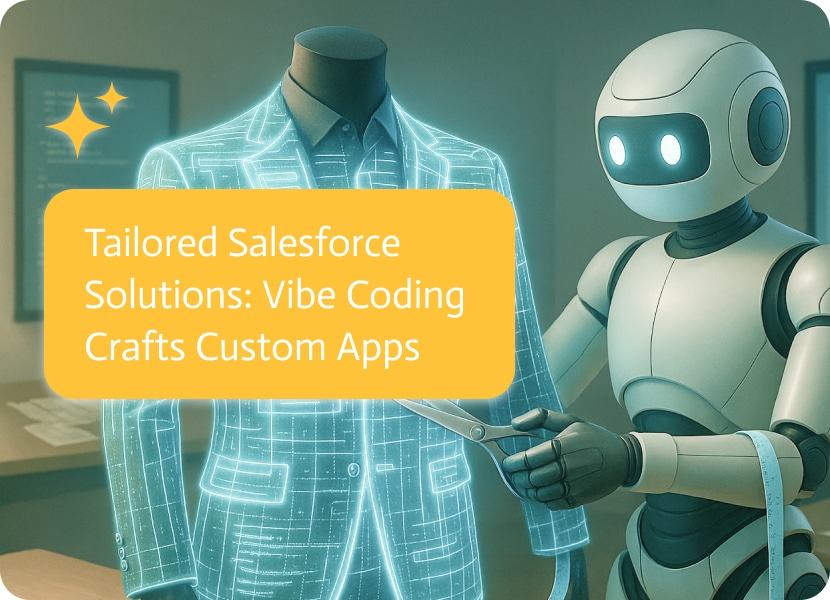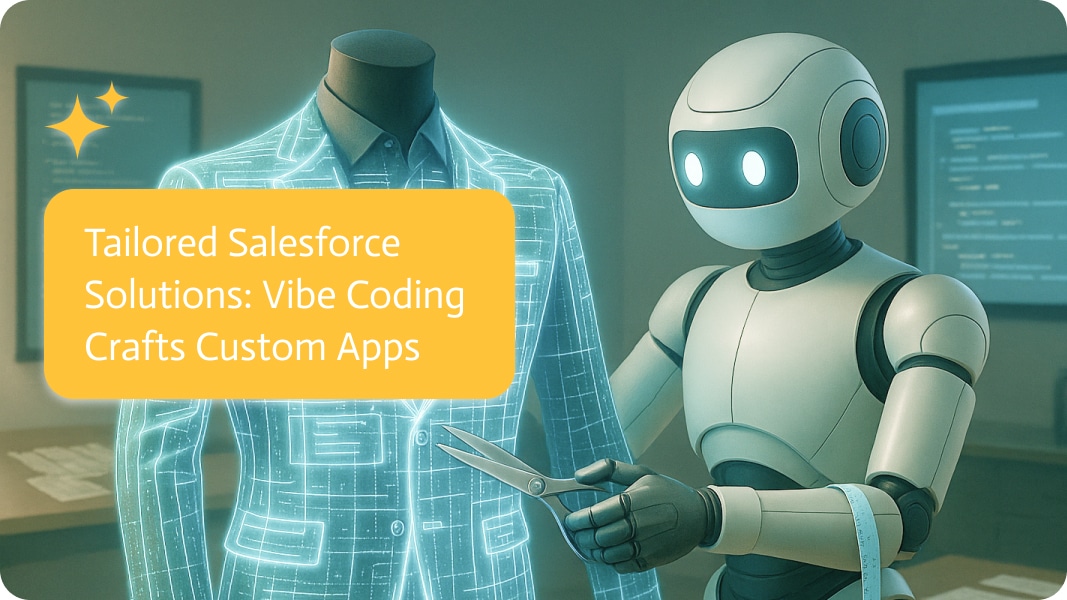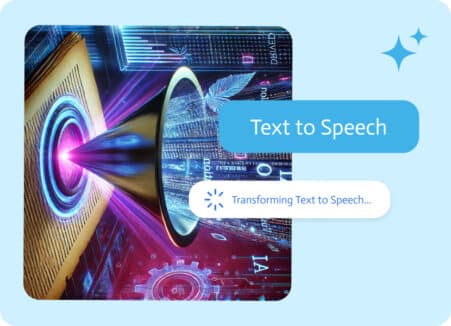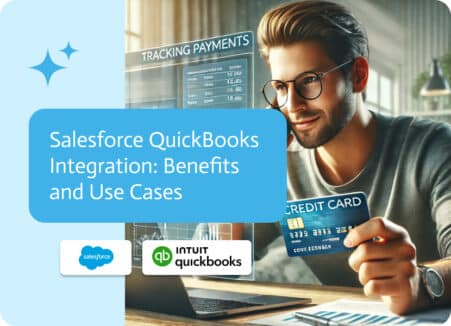

Tailored Salesforce Solutions: Vibe Coding Custom Apps
Anyone who’s ever used Salesforce is fully aware of just how helpful a tool it is for keeping track of everything customer-related. It can do nearly anything, from finding new customers to keeping your current ones happy. But it’s not magic right out of the box. To get the most from it, you have to set it up just right for how your company works. Too often, companies end up trying to bend their processes to fit Salesforce instead of tailoring Salesforce to fit their processes.
Vibe coding is a new way of shaping software that takes the restrictiveness out of CRM customization. Simply put, vibe coding is all about talking to software and achieving development through AI app generation. None of that technical jargon nonsense — users describe what they want in plain language, and the system translates those descriptions into working applications inside Salesforce. By saying, “I want a report that shows me which customers might cancel their service this month, based on what they’ve bought in the past, and also support tickets,” it’s built for you.
Let’s take a good look at how vibe coding does its thing, how you can use it to tweak Salesforce, and why it’s making life way simpler for businesses. By the end, you’ll see not only what this hoo-hah is all about but also the ways in which it improves how your team works with Salesforce.
How Vibe Coding Works in Salesforce Custom Apps
Think of vibe coding as a translator that links intent, which is conveyed with language, with the actual software execution. Traditionally, to create a custom Salesforce application, you’d need someone fluent in Apex (aka Salesforce Code), experience with Lightning components, and enough patience, thanks to Salesforce’s endless configuration menus. That meant weeks of requirements gathering, coding, testing, and let’s not forget about doing it all again, over and over again.
With vibe coding, you just describe what you want, and it figures everything out. It’s like magic:
- Intent: The system takes your input (“I want an app that assigns high-value leads to senior reps within 30 minutes”) and breaks instructions into logical phases.
- Translation: Then, it makes a technical blueprint, such as triggers and workflows that help with organization.
- Execution: The app is made, and it modifies Salesforce configurations in real time, ready for use and refinement.
What makes this revolutionary isn’t just speed; it’s accessibility. All of a sudden the ability to build apps isn’t locked away behind expensive consultants or uncontactable devs living in their own worlds. Instead, the people closest to the problem, sales reps, marketing, and customer service, can sketch out solutions themselves. No tech wiz needed.
What Businesses Can Build with Vibe Coding
It’s easy to say “custom apps,” but what does that mean in practice? Salesforce already boasts a solid selection of features out-of-the-box, but video coding is going beyond the standard features already supplied. Some examples of what organizations are creating:
Tailored lead-scoring systems: rather than generic lead ratings, you build algorithms that weigh factors unique to their industry. An estate agency could sort leads depending on property budget, response time, and neighborhood preferences, while a SaaS company is able to target engagement and free-trial usage.
Dynamic sales workflows: Imagine an automated process that shifts who’s in control of a deal when a customer does the thing or cautions managers about difficult potential customers. With vibe coding, it is now easy to set up these rules without settings.
Custom reporting dashboards: Standard Salesforce dashboards are great, but they don’t always show what’s important to your business. A vibe-coded report could combine advertising spending, customer happiness scores, and how long it takes to fix service issues all in the same place. No need to mess with numerous spreadsheets or extra apps.
Client-specific portals: There are loads of businesses already leveraging vibe coding to build lightweight client portals directly tied to Salesforce data. This means customers can log in, track their orders, or even submit a help query without the need for a clunky third-party system.
Automated compliance trackers: For heavily regulated industries, vibe coding allows quick creation of trackers that flag transactions that might fall outside compliance rules.
The true beauty here isn’t just in building apps, but more so in tailoring Salesforce to feel like it was designed for your business alone.
Benefits of Using Vibe Coding in Salesforce
The obvious draw is efficiency, but there are hidden advantages. Let’s break down the deeper benefits:
- Faster innovation: Traditional customization can take months. Vibe coding compresses that into days or even hours. You respond to shifting markets, new regulations, or emerging customer needs faster, essentially skipping IT backlogs.
- Closer alignment with operations: The people creating solutions are often the same ones living with the problems. Now apps are created to handle real-world scenarios.
- Cost savings: Salesforce consultants are expensive, and developer hours rack up fast. Vibe coding takes away the need for outside talent by putting customization power into the hands of your existing team.
- Empowered employees: There’s a psychological benefit too. When employees can design their own tools, there’s a sense of ownership of workflows, which often translates to better adoption levels, as well as greater satisfaction.
- Scalability: Because vibe coding integrates seamlessly with Salesforce’s core infrastructure, apps built this way scale just like any other Salesforce feature. You don’t need to worry about outgrowing your solutions as your business expands.
How to Get Started with Salesforce Vibe Coding
Implementing vibe coding in Salesforce isn’t about replacing your developers, it’s about giving your business another layer of capability.
- Identify problems: Start by asking teams where Salesforce feels clunky or limited. Common frustrations often point to impactful solutions.
- Experiment small: Don’t try to rebuild your entire CRM in one go. Try something manageable, like a lead-routing rule or a tailored dashboard.
- Iterate fast: The beauty of vibe coding is rapid iteration. Deploy, test, tweak, repeat. The more you adjust, the more the system learns the business trends.
- Use with traditional dev: Should your needs be more complex, vibe coding can act as the first draft, with developers fine-tuning the details afterward.
- Train teams: While no technical knowledge is required, guiding employees on how to frame prompts effectively is probably one of the most underrated aspects currently.
How Vibe Coding Is Transforming the CRM Industry
Vibe coding is a piece of a bigger move toward the future. For years, CRMs were considered powerful but intimidating. Low-code and no-code solutions were the first step toward democratization, but vibe coding has gone beyond this by eliminating the drag-and-drop complexity.
Vibe coding is part of a bigger move toward the future. For years, CRMs were considered powerful but intimidating. Low-code and no-code solutions were the first step toward democratization, but vibe coding has gone beyond this by eliminating the drag and drop complexity.
Noca’s platform combines vibe coding with an autonomous AI agent platform, allowing users to create predictive and adaptive CRM tools. Instead of just responding to instructions, these AI agents can anticipate needs. Imagine logging in on Monday morning and having Salesforce suggest, “It looks like potential sales are low for Q4. Do you want help creating a tracker for the sales team?”
There are also advantages with regard to industry specialization. Banks, hospitals, and manufacturers each have highly specific workflows that off-the-shelf CRM gadgets handle, but they often fall short when it comes to support. Noca’s vibe coding and AI agent platform enables hyper-personalized apps that redefine vertical-specific CRM strategies.
That does not mean there aren’t challenges. Governance will be key, because just because everyone can build does not mean every app should be built. Businesses will need policies to prevent redundancies, ensuring security, compliance, and proper tracking of integrations as vibe coding and AI agents gain adoption.
A Final Thought
Salesforce has always been about managing relationships with consumers, and with vibe coding, this is less of a rigid platform and more like clay in your hands. Instead of pushing the business into pre-built frameworks, you mold Salesforce around your workflows, your customers, and even your digital employees.
The biggest win isn’t just technical. It’s cultural. If staff can feel empowered to build tools that actually reflect their day-to-day needs, adoption soars, frustration falls, and the CRM stops being “that system we have to use” and becomes “that system we rely on.”
So, no matter if you’re a startup trying to survive against competitors or a large company with massive operations, vibe coding allows the user to create a unique version of Salesforce. Special apps are not something extra, but they’re becoming necessary to be able to compete.


